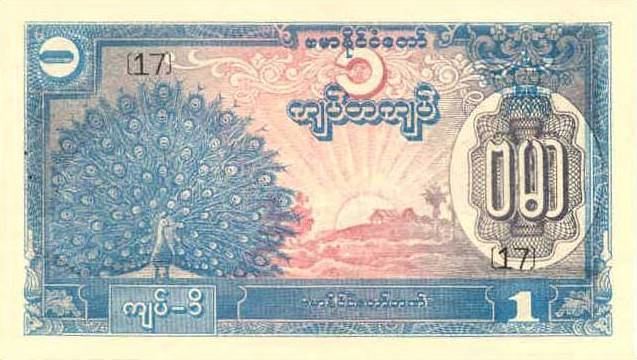1 kyat (1990) 1,000 kyats (2004) ⁄100 pya | Code MMK Symbol K | |
 | ||
Banknotes K5, K10, K20, K50, K100, K200, K500, K1000, K5000, K10,000.
Rare. 50 pyas, K1. Coins K5, K10, K50, K100.
Rare. K1 | ||
The kyat (/kiˈɑːt/, /ˈtʃɑːt/ or /ˈkjɑːt/; Burmese: ကျပ် [tɕaʔ]; ISO 4217 code MMK) is the currency of Burma (Myanmar). It is often abbreviated as "K" (singular or plural) or "Ks" (plural), which is placed before or after the numerical value, depending on author preference.
Contents
Current MMK exchange rates
From 2001-2012, the official exchange rate varied between 5.75 and 6.70 kyats per US dollar (8.20 to 7.00 kyats per euro). However, the street rate (black market rate), which more accurately took into account the standing of the national economy, has varied from 750 kyats to 1335 kyats per USD (985 to 1475 kyats per EUR). The black market exchange rates (USD to MMK) decrease during the peak of the tourist season in Burma (December to January).
On 2 April 2012, the Central Bank of Myanmar announced that the value of the kyat against the US dollar would float, setting an initial rate of K 818 per US dollar.
On 20 March 2013, the Finance Ministry announced that it would abolish Foreign Exchange Certificates (FEC), which were mandatory for tourists to buy at least US$200 worth of until 2003, a measure used to stop visitors from exchanging on the black market.
First kyat, 1852-1889
The kyat was a denomination of both silver and gold coinages in Burma until 1889. It was divided into 20 pe, each of 4 pya, with the mu and mat worth 2 and 4 pe, respectively. Nominally, 16 silver kyats equal 1 gold kyat. The silver kyat was equivalent to the Indian rupee, which replaced the kyat after Burma was conquered by the British.
Second Kyat, 1943-1945
When the Japanese occupied Burma in 1942, they introduced a currency based on the rupee. This was later replaced by banknotes in all kyat denominations. This kyat was subdivided into 100 cents. The currency became worthless at the end of the war when the Burmese rupee was reintroduced in 1945.
Third kyat, 1952-
The present kyat was introduced on 1 July 1952. It replaced the rupee at par. Decimalisation also took place, with the kyat subdivided into 100 pya.
First kyat
In 1852, Mindon, the second last king of Burma, established the Royal Mint in Mandalay (Central Burma). The dies were made in Paris. Silver coins were minted in denominations of 1 pe, 1 mu (2 pe), 1 mat (4 pe), 5 mu (10 pe) and 1 kyat, with gold 1 pe and 1 mu. The obverses bore the Royal Peacock Seal, from which the coins got their name. The reverse contained the denomination and mint date (in the Burmese era, which starts from AD 638). In the 1860s and 1870s, lead coins were issued for 1⁄8 and 1⁄4 pya, with copper, brass, tin and iron 1⁄4 pe (1 pya) and copper 2 pya. Further gold coins were issued in 1866 for 1 pe, 2 1⁄2 mu and 1 kyat, with 5 mu issued in 1878.
Second kyat
No coins were issued for this currency.
Third kyat
In 1956, coins were introduced for 1, 5, 10, 25 and 50 pyas and 1 kyat. The new coins bore the same obverse figure of the Chinthe from the Second kyat coins and the same reverse design, with the value of the coin in Myanmar writing and numerals surrounded by Myanmar flower designs.
In 1966, all coins were redesigned to feature Aung San on the obverse and were all changed in composition to aluminium. Furthermore, the coins were slightly reduced in size. However, they retained the same shapes and overall appearance of the previous series of coins. These were circulated until being discontinued in 1983.
In 1983, a new series of coins was issued in bronze or brass 5, 10, 25, 50 pyas and cupro-nickel 1 kyat. Although the 25 pyas were initially round, it was later redesigned as hexagonal due to size and appearance confusions with the 10 and 50 pyas. These would be the last official series of coins to be issued under the name of "Burma."
1 pya coins were last minted in 1966, with the 5 and 25 pyas last minted in 1987 and the 10 and 50 pyas in 1991.
In 1999, a new series of coins was issued in denominations of bronze 1 kyat, brass 5 and 10 kyats, and cupro-nickel 50 and 100 kyats under the name "Central Bank of Myanmar." These are also the first coins of Burma to depict Latin letters. These coins were intended for vendors and services as an alternative to large amounts of worn out, low denomination banknotes. High inflation has since pushed these coins out of circulation.
In late 2008, the Myanmar government announced that new 50 and 100 kyat coins would be issued. According to newspaper articles, the new 50 kyat coin would be made of copper, with the usual Burmese lion on the obverse and the Lotus Fountain from Naypyidaw on the reverse. The 100 Kyat coin would be of cupro-nickel and depict the Burmese lion on the obverse and the value on the reverse.
